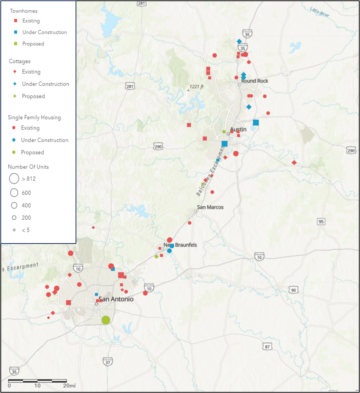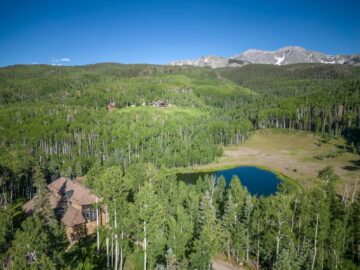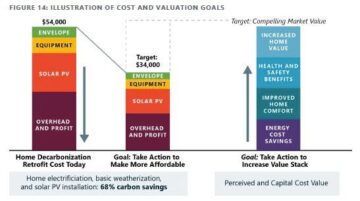
Hurricanes, tornadoes and floods likely drive more headlines, but severe heat waves are actually the most dangerous weather events humans face. According to Scientific American, they’re deadlier than the other three hazards combined. There’s plenty of reporting about the effects extreme heat has on our bodies, and even on our mental health, but what about the safety and resilience of the homes we depend on for shelter? They’re impacted too.
“Although designing for extreme heat is not yet mainstream in many U.S. markets, it is likely to become more prevalent as extreme heat increases,” predicted a 2019 study from the Urban Land Institute, a global nonprofit focused on real estate and development-related development education and research. There isn’t a one-sized-fits-all approach or solution, as the study, appropriately named Scorched: Extreme Heat and Real Estate, pointed out. Different humidity levels, tree cover, and other local factors come into play.
What can we do to keep ourselves, our families and our homes safe as the mercury climbs? New approaches, technologies and mitigation policies can all help, but we may need new maintenance strategies too while those are being developed and tested.
Impacts
ULI’s vice president of urban resilience, Lindsay Brugger, noted in an email that the organization uses the “extreme heat” term to refer to conditions above a location’s baseline normal temperatures, as well as to extreme temperatures hit during heat waves. “A building’s roof, facade, and foundation are all susceptible to extreme heat impacts,” she explained.
“While excessive heat can put a strain on all of our home’s infrastructure, the roof, air-conditioning system, and horizontal wood surfaces like a deck or handrails will certainly be most impacted,” added Corbin Clay, a Raleigh, North Carolina area custom home builder and founder of homeowner advice platform Wayhome, also by email.
Roofing
“Your home’s roof really takes a beating in excessive heat,” Clay noted. “Direct sunlight and increased temperatures can cause blistering, warping, and cracking on any roof material, especially asphalt shingles. Additionally, any rubber boots around vents or rubberized sealants (like caulk or tar) can become dry and brittle, potentially leading to leaks.”
Brugger pointed to the science center in Glasgow – not exactly a sunbelt city – whose roof membrane melted during an extreme heat event in 2018, (though building executives noted that the roof structure itself was unaffected). The temperature in the Scottish metro that day that day was the equivalent of 89.42 degrees Fahrenheit.
For comparison, Phoenix, Arizona broke heat records this past July with an average high of 114.7 degrees, and states across the country have been sweltering under excessive heat. How hot is it where you live – and how quickly does the weather shift into fall or winter temperatures? “A home’s shingles may dry out, then contract and crack as temperatures cool,” Brugger warned.
Siding and Foundations
“The materials that comprise a building’s façade may shrink and/or expand during extreme heat events,” the ULI executive added. Depending on how the materials are joined, this can damage them or create gaps in the façade where moisture can penetrate, she cautioned.
“Extreme heat can contribute to drought conditions which, depending on soil composition, may cause soil to shrink. This can lead to uneven settlement and cracks in the foundation as well as cracks in interior and exterior walls, uneven floors, and doors and windows that do not seal properly,” she also observed.
Mechanical Systems
“To reach the temperature you require for comfort, the system will need to work longer, and that can lead to premature wear and tear. To help prevent this excessive load, it’s a good idea to find a comfortable higher temperature (usually around 78º) for your thermostat setting,” Clay recommended.
“A well-insulated building envelope with double or triple pane windows and minimal air leakage will increase occupant comfort while reducing the cooling load for HVAC equipment,” Brugger suggested, adding, “Installing energy efficient HVAC equipment and LED lighting can further reduce the cooling load by minimizing waste heat.”
Maintenance
“High temperatures can increase the rate of wear on building materials such as facades and roofs, accelerating deterioration and the need for repair or replacement,” shared Brugger. (Humidity can add mold and mildew risk.)
Clay agreed: “Extreme heat can drastically increase a home’s maintenance needs and costs. The additional energy needed to cool your home will result in higher electricity bills, and exterior finishes and materials will fail prematurely. These will need to be maintained more often (like exterior paint and caulking), and surfaces that should last for decades like your roof, asphalt driveways, and wood decking will likewise need to be replaced much sooner. With regard to your roof, “Once temperatures cool in the fall, it’s a good idea to have [it] inspected to ensure everything is still water-tight,” he suggested.
Simple Pro Tips
Clay offered these additional suggestions for reducing the impact of heat on your home:
- First, make sure your air conditioner’s filter is clean. A new filter can help reduce the load placed on the unit and increase the overall airflow and efficiency.
- Second, using black-out curtains or shades can drastically reduce the temperature inside by blocking the sun’s harmful rays. This too can help prevent damage to pieces inside like electronics, flooring, and furniture that may be harmed by excessive heat. Additionally, heat-control film can be applied to east and west facing windows that will reflect the sun’s heat without blocking your views.
- Finally, up to 40% of a home’s energy loss comes not from insufficient insulation, but rather air leaks. Drafty windows and doors, and penetrations through ceilings (think bathroom vents and recessed lights) can all lead to conditioned air escaping, and unconditioned air sneaking in. Caulking windows, adding weather stripping to doors, and air-sealing ceiling penetrations with spray foam are all excellent ways to eliminate this energy loss.
Here are 10 additional tips to keep your home cooler during heat waves.
New Construction
If you’re building a new home or a major addition, orientation is crucial. “The strategic orientation of a building, doors, and windows helps minimize solar heat gain and optimize ventilation,” Brugger commented. “Typically, buildings are oriented north–south to reduce sun exposure, and windows are oriented toward the prevailing winds to maximize cross breezes. Shade producing landscape features or building elements can further minimize heat gain in both new construction and existing buildings.”
You should also be strategic in your material choices, she advised. “It is important to select materials that can withstand a wide range of temperatures and to detail material connections in a manner that accommodates potential shrinkage or expansion due to extreme heat. In locations with cooler nighttime temperatures, heavy, dense materials with high thermal mass – such as concrete, tiles, brick, and stone – can keep a building cool and modulate temperature swings by absorbing daytime heat and release it slowly at night if and when the temperature drops.”
You may not have heard the term “cool roof” or “cool walls,” but both are designed to reflect sunlight and absorb less heat, reducing the ambient temperature of indoor and outdoor spaces. In areas with reliable water sources, green roofs and walls can also mitigate extreme heat effects. (They have other benefits too, including wellness-enhancing biophilia.)
“If heat-resistance is a priority, there are many great options for homeowners when making material selections: using high-heat elastomeric exterior paints, selecting lighter colors for horizontal surfaces like decking and roofing, and using more energy-efficient windows with low-E, light-reflective glass are all great ways to not only prevent potential heat-related damage, but help to keep your home cooler throughout the hot summer months,” Clay advised.
- SEO Powered Content & PR Distribution. Get Amplified Today.
- PlatoData.Network Vertical Generative Ai. Empower Yourself. Access Here.
- PlatoAiStream. Web3 Intelligence. Knowledge Amplified. Access Here.
- PlatoESG. Automotive / EVs, Carbon, CleanTech, Energy, Environment, Solar, Waste Management. Access Here.
- PlatoHealth. Biotech and Clinical Trials Intelligence. Access Here.
- ChartPrime. Elevate your Trading Game with ChartPrime. Access Here.
- BlockOffsets. Modernizing Environmental Offset Ownership. Access Here.
- Source: https://www.forbes.com/sites/jamiegold/2023/08/22/protecting-your-home-from-extreme-heat-damage/
- :has
- :is
- :not
- :where
- $UP
- 10
- 2018
- 2019
- 7
- a
- About
- above
- accelerating
- According
- across
- actually
- add
- added
- adding
- addition
- Additional
- Additionally
- advice
- agreed
- AIR
- All
- also
- Ambient
- American
- an
- and
- any
- applied
- approach
- approaches
- appropriately
- ARE
- AREA
- areas
- arizona
- around
- AS
- At
- average
- Baseline
- BE
- become
- been
- being
- benefits
- Bills
- blocking
- bodies
- Boots
- both
- Broke
- builder
- Building
- Building Materials
- buildings
- but
- by
- CAN
- Carolina
- Cause
- ceiling
- Center
- certainly
- choices
- City
- COM
- combined
- come
- comes
- comfort
- comfortable
- commented
- comparison
- composition
- conditions
- Connections
- construction
- contract
- contribute
- Cool
- Costs
- country
- cover
- crack
- create
- Cross
- crucial
- custom
- damage
- Dangerous
- day
- decades
- dense
- Depending
- designed
- designing
- detail
- developed
- Development
- different
- do
- does
- doors
- double
- drastically
- drive
- Drops
- Drought
- dry
- due
- during
- East
- Education
- effects
- efficiency
- efficient
- electricity
- Electronics
- elements
- eliminate
- energy
- ensure
- equipment
- Equivalent
- especially
- estate
- Even
- Event
- events
- everything
- exactly
- excellent
- executive
- executives
- existing
- Expand
- expansion
- explained
- Exposure
- extreme
- façade
- Face
- facing
- factors
- FAIL
- Fall
- families
- Features
- Film
- filter
- Find
- floors
- Foam
- focused
- For
- Forbes
- Foundation
- founder
- from
- further
- Gain
- gaps
- glass
- Global
- good
- great
- Green
- harmful
- Have
- he
- Headlines
- Health
- heard
- heavy
- help
- helps
- High
- higher
- Hit
- Home
- Homes
- Horizontal
- HOT
- How
- http
- HTTPS
- Humans
- hvac
- idea
- if
- Impact
- impacted
- Impacts
- important
- in
- Including
- Increase
- increased
- Increases
- Indoor
- Infrastructure
- inside
- Institute
- interior
- into
- IT
- itself
- joined
- jpg
- July
- Keep
- Land
- landscape
- Last
- lead
- leading
- Leaks
- Led
- less
- levels
- lighter
- Lighting
- like
- likely
- likewise
- live
- load
- local
- locations
- longer
- loss
- Mainstream
- maintenance
- major
- make
- Making
- manner
- many
- Markets
- Mass
- material
- materials
- Maximize
- May..
- mental
- Mental health
- Mercury
- Metro
- minimal
- minimize
- minimizing
- Mitigate
- mitigation
- months
- more
- most
- much
- Named
- Need
- needed
- needs
- New
- New Construction
- night
- Nonprofit
- normal
- North
- north carolina
- noted
- observed
- of
- offered
- often
- on
- only
- Optimize
- Options
- or
- organization
- Other
- our
- ourselves
- out
- Outdoor
- overall
- paint
- pane
- past
- phoenix
- pieces
- platform
- plato
- Plato Data Intelligence
- PlatoData
- Play
- Plenty
- policies
- potential
- potentially
- predicted
- Premature
- president
- prevailing
- prevalent
- prevent
- priority
- Pro
- producing
- properly
- protecting
- put
- quickly
- raleigh
- range
- Rate
- rather
- reach
- real
- real estate
- really
- recommended
- records
- reduce
- reducing
- reflect
- regard
- release
- reliable
- repair
- replaced
- replacement
- Reporting
- require
- research
- resilience
- result
- Risk
- roof
- rubber
- s
- safe
- Safety
- Science
- scientific
- selecting
- setting
- settlement
- severe
- shared
- she
- Shelter
- shift
- should
- Slowly
- soil
- solar
- solution
- Sources
- spaces
- States
- Still
- STONE
- Strategic
- strategies
- stripping
- structure
- Study
- such
- summer
- Sun
- sunlight
- sure
- susceptible
- Swings
- system
- takes
- Technologies
- term
- tested
- than
- that
- The
- Them
- then
- There.
- thermal
- thermostat
- These
- they
- Think
- this
- those
- though?
- three
- Through
- throughout
- tips
- to
- too
- toward
- tree
- Triple
- u.s.
- unaffected
- under
- unit
- urban
- uses
- using
- usually
- vice
- Vice President
- views
- was
- Waste
- Water
- waves
- ways
- we
- Weather
- WELL
- West
- What
- when
- which
- while
- whose
- wide
- Wide range
- will
- windows
- winds
- Winter
- with
- without
- wood
- Work
- yet
- you
- Your
- zephyrnet












